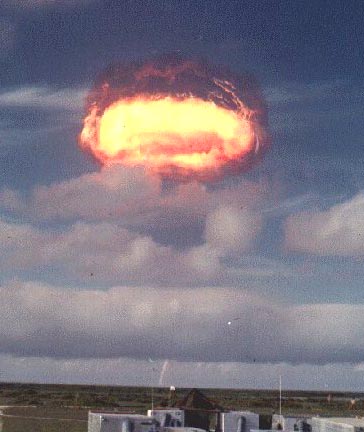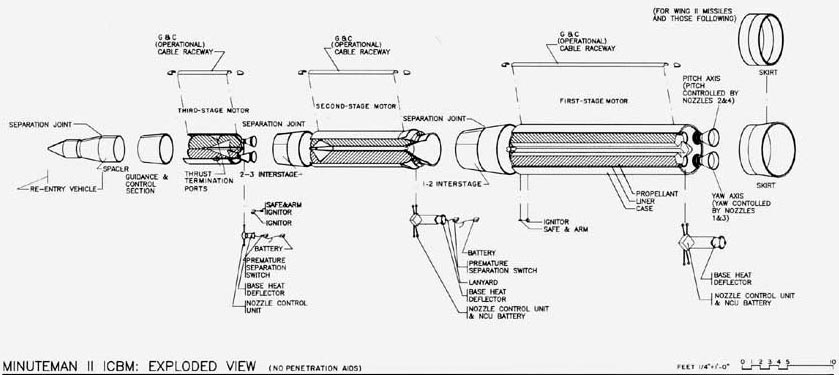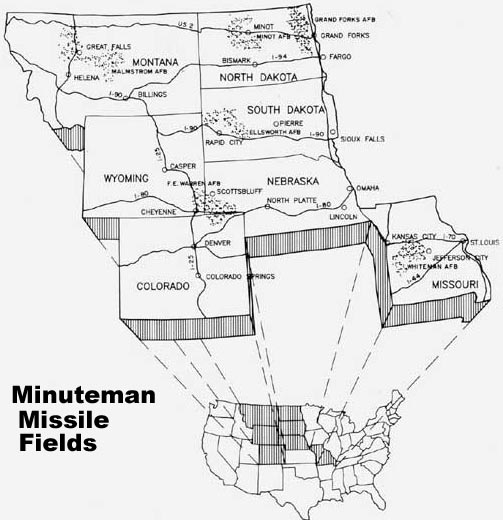and
Ellsworth Airbase
“Good people sleep peaceably in their beds at night only because rough men stand ready to do violence to those who would do them harm."
-- George Orwell


| Back
to Home |
Back to
Nuclear Tourist |
Back
to Travel |
| Minuteman Missile and Ellsworth Airbase |
||
|
“Good people sleep peaceably in their beds at night only because rough men stand ready to do violence to those who would do them harm." -- George Orwell 
|
||

|
||
| Introduction |
The monument |
The command Center |
| The Silo |
Ellsworth Airbase |
Links |
Out in the middle of nowhere, stand the missile fields of the United States Air Force. Strictly speaking, of course, this is not the middle of nowhere. The missile  fields of South Dakota are near cities, towns, several state and national
parks, and numerous tourist attractions. They are also very close to major
highways, so close that many of the facilities can be seen from Interstate
90, if the motorist knows where to look. Still, this is about as close to
the middle of nowhere as you can get in modern continental America. These
are very sparsely populated areas, and off of the main roadways, travel tends
to be difficult, and locations isolated.
fields of South Dakota are near cities, towns, several state and national
parks, and numerous tourist attractions. They are also very close to major
highways, so close that many of the facilities can be seen from Interstate
90, if the motorist knows where to look. Still, this is about as close to
the middle of nowhere as you can get in modern continental America. These
are very sparsely populated areas, and off of the main roadways, travel tends
to be difficult, and locations isolated. These were the original quick reacting ICBMs, and the second generation of nuclear missiles. The first generation had consisted of the huge and complicated Atlas, and Titan missiles. A diagram to the right shows the small size of the Minuteman, when compared to the previous Titan, and Atlas systems. Though the U.S. had possessed nuclear bombs for over a decade, before the invention of the ICBM, these missiles permitted the pushbutton warfare which so many politicians and generals had hoped that technology would offer. Unlike the nuclear bomber force, the ICBM required no one to fly into enemy territory. A young man, latter on a young woman, could sit in a comfortable chair, in a clean office like environment, and simply turn a key. This took warfare out of the mud of the trenches, or the thin cold air of distant skies, and allowed men to annihilate each other like gentlemen, in comfort. The specially picked crew who staffed the silos, were members of the Air Force, which was the service branch given control of all of the long range nuclear missiles. Though these people were warriors, in the sense that they were trained to unleash destructive forces upon enemies of their country, these were not the "rough men" of legend; they were very much technicians. Even so, there was a was a certain mettle to these people. They knew that, should they be called upon to perform their ultimate task, deep under the ground, they were as good as dead, and would never again see the sun or breathe the air of the surface. They also knew that the last act of their lives would be to ensure the death of possibly millions of people, and to change forever the course of humanity. These are not facts which lay lightly upon the human spirit, nor are they burdens which can be borne by the weak, the uncertain, or the frivolous. The Minuteman was designed in the late fifties, and deployed through most of the sixties. Development was set into motion by President Dwight D. Eisenhower. The idea behind the development of the new solid fuel missiles was to decrease cost and complexity, while increasing reliability and readiness. Where the Atlas missiles had required as much as four hours to launch, and even the most advanced versions of the Titan needed fifteen minutes, the Minuteman could be out of it's silo within three minutes of reception of the launch order. The Minuteman could also be launched directly out of it's launch silo, unlike the Atlas, and the earlier versions of the Titan, which needed to be raised out of their silos for launch. On top of all of this, the Minuteman was to be a very low profile, and inexpensive ICBM. Where the Titan, and Atlas facilities had been large expensive bases, the Minuteman silos, and launch control centers would be small, unobtrusive, and almost beneath notice. A minuteman silo had a cost of $400,000, compared to about two million dollars for an Atlas or Titan silo. The missiles themselves were also quite a bit smaller and less expensive. In contrast to the constant maintenance, which needed to be lavished upon the liquid fueled Titan, and Atlas systems, the solid fueled Minuteman could be left unattended, in it's remote silo, always fully ready for launch. 
 Minuteman missile fields were organized along the same lines
as air squadrons. An underground LCC (Launch Control Center) was assigned
a flight of ten missiles. Five flights (50 missiles) made up a squadron.
A wing consisted of three of four squadrons, containing 150 - 200 missiles.
The original deployment was of five wings. In a missile field, no silo or
command center is located within three miles of any other. This is to reduce
vulnerability of the system as a whole. It was thought that in a possible
nuclear strike, even a nuclear warhead would not be able to take out more
than a single part of the system. The system was hardened to the extent that
nothing short of a direct hit would disable any of the sites. Accuracy of
Soviet missile systems was such, that a hardened site had a very good chance
of surviving a nuclear strike.
Minuteman missile fields were organized along the same lines
as air squadrons. An underground LCC (Launch Control Center) was assigned
a flight of ten missiles. Five flights (50 missiles) made up a squadron.
A wing consisted of three of four squadrons, containing 150 - 200 missiles.
The original deployment was of five wings. In a missile field, no silo or
command center is located within three miles of any other. This is to reduce
vulnerability of the system as a whole. It was thought that in a possible
nuclear strike, even a nuclear warhead would not be able to take out more
than a single part of the system. The system was hardened to the extent that
nothing short of a direct hit would disable any of the sites. Accuracy of
Soviet missile systems was such, that a hardened site had a very good chance
of surviving a nuclear strike.The 44th Strategic Missile Wing (SMW) at Ellsworth Air Force Base was activated on 1 January 1962. On 1 July 1962 SAC activated the first of South Dakota's Minuteman squadrons. The Air Force located missile sites near the existing Ellsworth Air Force Base in order to provide logistical support to the facilities. The missiles were located within an area approximately one hundred miles east and north of the base, in an expanse covering approximately 13,500 square miles of western South Dakota. The three Minuteman I ICBM squadrons at Ellsworth Air Force Base, each consisting of five LCFs and fifty LFs, were located in the vicinity of the communities of Wall, Union Center, and Belle Fourche. SAC declared all three Strategic Missile Squadrons (SMS) combat ready on 1 November 1963. Even as the Air Force began deploying Minuteman I missiles in 1962, research and development into the Minuteman II had already begun. The new Minuteman II would have a better than 7,000 mile range, as opposed to the 6,300 mile range of the earlier version, and would be able to carry the more powerful W-56 warhead. The first test launch of Minuteman II occurred at Cape Canaveral in 1964 and the first operational launch occurred one year later. Ellsworth missile field, was upgraded to a Minuteman II installation in the early 1970s. No major structural modifications were necessary for this conversion, and over the years, these facilities were subject to limited new construction and remodeling. By 1975, all of the nation's Minuteman silos contained the Minuteman II. The Strategic Arms Reduction Treaty (START), which US President George Bush and Soviet leader Mikhail Gorbachev signed in Moscow on July 31, 1991, sought to greatly reduce delivery vehicles for nuclear weapons. A major part of this reduction was the decommissioning of a proportion of the ICBM force. While the newer Minuteman III, and MX missiles would remain in service, the Minuteman II was to be retired, and not replaced. In September 1991, all 450 of the nation's Minuteman II missiles were taken off alert. The deactivation began on 3 December 1991, with the removal of the missile from the Golf-02 silo near Red Owl, South Dakota. The removal of the Air Force's first Minuteman II at Ellsworth Air Force Base in South Dakota marked the beginning of the country's Minuteman II disarmament effort. The last Minuteman II missile in South Dakota was removed from its silo in April 1994. Once a missile site was decommissioned, the missile was removed, along with any valuable or sensitive equipment, and then the site was imploded. The land was then put up for sale, with first right of refusal to go to the original owner. The implosions did not completely fill the silos, or underground bunkers, and it was thought that collapsing the first six feet or so would make the installations unusable. New owners were forbidden to dig down to the remaining underground installations, and could only dig wells or other such structures within guidelines, or by special request. The Air Force did not want people to refurbish the old installations, since this could be considered a violation of the START treaty. After nearly fifty years, the Cold War was over, and it's weaponry was being, if not retired, at least minimized. No longer having a mission to perform, SAC was officially deactivated 1 May 1992 and was replaced by the U.S. Strategic Command, known as USSTRATCOM. On 1 October 2002 USSTRATCOM and U.S. Space Command both disestablished and a new U.S. Strategic Command stood up at Offutt Air Force Base, responsible for both missions. |
 If you are living in South Dakota, or happen to be
passing through, or visiting, you will probably stop at the Black Hills,
and at the Badlands. These are both amazing places, and are a big draw for
the state. The Badlands tend to be a drive through, for tourists on their
way to the Black Hills, or to Yellowstone Park. Most vacationers traveling
through this area will drive the loop road, stop at a couple of scenic overlooks,
and continue on their way. Total time spent, perhaps an hour or two. If you
are coming from the east, the badlands scenic loop starts at exit 131, and
empties back onto the the freeway at Wall, South Dakota, around exit 109.
It is a marvelous road.
If you are living in South Dakota, or happen to be
passing through, or visiting, you will probably stop at the Black Hills,
and at the Badlands. These are both amazing places, and are a big draw for
the state. The Badlands tend to be a drive through, for tourists on their
way to the Black Hills, or to Yellowstone Park. Most vacationers traveling
through this area will drive the loop road, stop at a couple of scenic overlooks,
and continue on their way. Total time spent, perhaps an hour or two. If you
are coming from the east, the badlands scenic loop starts at exit 131, and
empties back onto the the freeway at Wall, South Dakota, around exit 109.
It is a marvelous road. Wall Drugs is a legend, and the mother of all tourist traps. It has been around for over 80 years, while The Badlands themselves have been drawing tourists since before the automobile. South Dakota itself is the stereotypical American West, with prairie, semi desert, ranches, and rolling hills. There are Indian reservations, old cowboy towns, abandoned mining camps, and remnants of old trading and military posts. In the midst of all of this wonder, is the National Park Service's newest monument, Minuteman Missile NHS. The monument consists of a launch control center, and a silo, separated by about 11 miles of South Dakota prairie. The monument is still a work in process. The park headquarters consists of a pair of trailers, located next to the BP gas station off of exit 131, on I90 in South Dakota. This is the same exit that westbound tourists use to enter the Badlands loop road. It is easy to miss the trailers, and to ignore the simple Park Service sign announcing the site. This is one of the more unusual properties of the NPS, due to the distance and isolation of the locations, and it is still attempting to get a handle on just how to administer the site, and make it available to the public. Near the trailers is a message board, with some information about the park, and about some nearby attractions. Inside the visitors trailer are some photographs, a case with some badges and uniforms, and a photo album. There is a counter, with a park service staffer, and some brochures, and handouts. This is the meeting place for the guided tours of the facilities administered by the park service. If you have come this way from the West, you have passed the actual units of the site. The silo is located off of exit 116, while the LCC is located off of exit Construction of Delta-01 had been completed on 29 November 1962 at an estimated cost of just over $800,000 and construction of Delta-09 was completed on 26 November 1962 at an estimated cost of $354,500. The final costs for the construction of the Minuteman missiles in South Dakota may have been as high as $75.7 million. Delta-01 and Delta-09 were turned over to the Strategic Air Command (SAC) on 1 November 1963, making them among the first Minuteman sites to be activated at Ellsworth Delta-01 and Delta-09 were deactivated in early 1993 and placed on "caretaker status." Deactivation included the removal of the Minuteman II missile and warhead from Delta-09 and the removal of classified electronic equipment, hazardous materials, environmentally sensitive materials, and equipment saved for use at other sites from both Delta-01 and Delta-09. To the greatest extent possible, the facilities were left to appear as they had when they were first taken off alert. The live missile had been removed, and the silo stood empty. To make a satisfactory exhibit, a new missile would have to be found. Components of a training missile, which was visually, and to a certain extent, mechanically identical to a real Minuteman II were found at Hill Air Force Base in Utah. The training missile was refurbished, and on 12 June 2001 the Air Force emplaced the missile in the Delta-09. On 27 September 2002, exactly eleven years to the day from stand down, the Air Force officially turned Minuteman Missile National Historic Site over to the NPS. NPS now needed to set up the sites for public visitation, incorporate historical data, and find proper guides, and personnel. By 15 August 2001 the viewing enclosure, of Delta-09 was largely completed. After the installation of the static display missile and the completion of the viewing enclosure, a Soviet inspection team traveled to South Dakota on 21 May 2002 to verify that Delta-09 complied with the START Treaty's specifications for static displays. Visiting the Monument
As of this writing, the Minuteman Missile NHS is open
Monday through Friday, 9 to 5, and takes two tours a day to the Delta-01 LCC,
and to the Delta-09 silo. The schedule is determined by the staffing, including
volunteer staffing. TheAs was mentioned above, the trailer headquarters is next to the BP gas station , off of exit 131, on Interstate 90. This is the same exit taken to Enter Badlands National Park, and the Badlands loop road. Visitors will need their own cars, since there will be a drive out to the two actual locations. Showing up a bit early will permit a viewing of the exhibits located at the headquarters trailers, and will give a few moments to talk to the staff members, and to the guide. Though the hours marked on the door indicate that the office does not open until 9 AM, I was able to enter at about 8:20. Once checked in, I was free to go to the BP station, and grab myself a bit of breakfast, and something to drink. Once the group has met, the guide, who in this case was a retired Air Force officer who had actually worked the silo during the Cold War, explains that the tour will last approximately two hours, He also warns that anyone who does not care for enclosed spaces should consider staying behind, and that there are no usable bathroom facilities at the Delta-01 LCC (Delta-09 has a porta potti). We are then told that we will drive our own vehicles, in convoy, behind him. The links below are to pages which detail the tour. |
| The
command Center (Start Here) |
The Silo
|
Ellsworth Airbase
|
Links
|